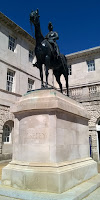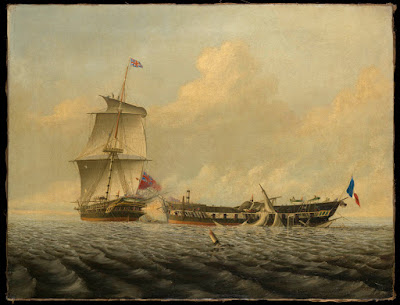High-quality radio communications today, and the associated
ability of ships in difficulty to transmit distress messages, make it difficult
to envisage just how desperate were the plights of shipwrecked crews in earlier
years. An earlier article (see links at the
end) touched on the sufferings of the survivors of the French
frigate Medusa in 1817, as were
immortalised in the painting by Theodore Gericault. Of these we know, only
because the remaining handful were rescued, but in hundreds of similar cases nobody
lived to tell of their experiences. One case, not unlike the Medusa’s, was however to occur in 1845
and also off West Africa. This involved the Royal Navy.
 |
| One of the most potent images in history - the symbol of Britain's Anti-Slavery Society |
Britain had abolished the Slave trade in 1807 and in the following
years many other nations were to follow her example. It was not however until the
Napoleonic Wars ended in 1815 that resources could be assigned to active suppression.
For some five decades thereafter in the Atlantic, and even longer in the Indian
Ocean, British warships were devoted to catching ships running slaves from
Africa to Brazil, the Caribbean or Arabia. The “preventative
squadron” of the West Coast of Africa Station was to constitute the main British
effort up to about 1860. Though punctuated by periods of intense action, monotonous
patrolling occupied most of the time and was made all the more hazardous for being
based at locations, like Lagos, where malaria was rampant. The annual mortality
rate was 55 per 1,000 men, compared with 10 for fleets in British waters or in
the Mediterranean. The ships employed by the Royal Navy were often not fast
enough to catch slavers, which were built, often expressly, for speed, and other governments, which gave
lip-service to the abolition of the trade (but not abolition of slavery itself),
were less than cooperative. France would
not allow boarding parties to search French-registered ships and the American,
Spanish, Portuguese, and Brazilian economies were so dependent on slave labour
that these governments had no incentive to act effectively.
 |
| A typical success of the Anti-Slavery patrol The capture of the slaver Gabriel by HMS Acorn, July 1841 by Nicholas M. Condy (Credit © National Maritime Museum London UK) |
By the 1840s some
25 vessels and 2,000 officers and men were on the West Africa Station and
supported by approximately 1,000 “Kroomen”, recruited mainly from Sierra Leone.
The Kroomaen came to be highly respected and were later to provide valuable
service in similar duties in the Indian Ocean. Monotonous as the patrolling may
have been, engagements could be very dramatic and very bloody when slavers were
run down. Just how bloody would be proved by the experiences of some of HMS Star’s crew.
 |
| Another success: Capture of the Slaver Formidable by HMS Buzzard, 17 December 1834 by William J. Huggins (Credit © National Maritime Museum London UK) |
On the 27th February 27th 1845 HMS Wasp, a Cruizer-class brig-sloop launched in 1812, was cruising in
the Bight of Benin off the Niger Delta, when a strange sail was seen and pursued. She was boarded in the early evening and found
to be a Brazilian schooner, the Felicidade.
Though apparently not carrying slaves – not yet – she was fitted for
transporting them and she carried a crew of 28. With the exception of her
captain and one other they were transferred to the Wasp. Command of the captured Felicidade
was assigned to the Wasp’s Lieutenant Stupart, supported by a Midshipman Palmer
and a crew of fifteen British seamen.
 |
| Prisoners found on a Slaver |
 |
| Slaves being loaded - one suspects that those who murdered the Felicidade's prize crew were not unlike the thugs shown here. |
On March 6th the hijacked Felicidade was spotted HMS Star,
another ship of the Anti-Slavery patrol. She was boarded and the crew was
questioned. They claimed that the vessel was called Virginie and that the wounded men on board had had been injured by a
falling spar. There was however sufficient evidence of a fight – blood stains
on the deck – and there were indications that British seamen had been on the
schooner. The captain and crew, now suspected
of murder, were taken on board the Star
for questioning in Sierra Leone. The Felicidade
was to proceed independently to St. Helena, where a prize court was established.
Command of her was assumed by a Lieutenant Wilson from the Star, supported by nine naval seamen.
Now sailing independently, the Felicidade encountered a heavy squall. She went over, filled, and
sank, so as only to leave part of her bow above water. When the squall passed the whole crew was left clinging to the bow
rail. Unsuccessful attempts were made to dive down to extract provisions from
the hull and it was clear that she was sinking gradually. Lieutenant Wilson kept
his nerve however. He found that there were three knives among the crew and he
decided to make a raft of the main-boom and gaff, and such other items floating
in the water. Ropes for binding them together were cut from the rigging, a
small mast was erected and a topgallant studding-sail was secured to it. On
this ramshackle raft ten men hoped to reach the African coast, 200 miles away,
without rudder, oar, compass, provisions, or water.
Their suffering was great in the twenty days that followed.
Almost naked, washed by every wave, unprotected against daytime sun or night-time
chill, they had no supplies of either fresh water or food and sharks hovered
near by. Five of their number were to die, two Kroomen among them the first to
go. Wilson did however manage to maintain control as well as hope. Rain fell
occasionally and it was caught in the sail and stored in a keg that had floated
out of the schooner. Ingenuity – and desperation – was to turn the circling
sharks into the only available source of food. A bowline was made at the end of
a rope and used – one can only wonder how many tries were made – to lasso an eight-foot
long shark and drag it on to the raft. They killed it, drank its blood, and ate
it. Three more sharks were taken in the same way and it was these that kept the
Wilson and four others alive until they were picked up in sight of land by HMS Cygnet.
The aftermath was amazing. The prisoners taken by HMS Star were taken to Britain to be tried
for piracy. The assize judge duly convicted them of murder – a capital offence.
Fine legal minds now found grounds for appeal. Did a British court-of-law have jurisdiction
over a vessel owned by a Brazilian who murdered a prize crew? The appeal
succeeded. The murderous thugs were released and transported back to Brazil at the
cost of the British taxpayer. One can well imagine the indignation in naval
circles and the sense of grievance felt by the families of the murdered men. They
had looked for natural justice and were rewarded by flagrant injustice based on
legal hair-splitting. “Remember the Felicidade!”
was a cry heard often thereafter on the Anti-Slavery Patrol. One suspects –
indeed hopes – that it might have led to some more summary justice on later
occasions.
Parallels with modern sensitives to legal niceties in relation
to pirates and others of their ilk are too obvious to need emphasis.
“Remember the Felicidade!”
-----------------------
To receive e-mail updates
on forthcoming Dawlish Chronicles publications, videos and occasional
give-aways, you can sign up via the box in the right-hand sidebar near the top of this article. You
will be asked to re-confirm once you have submitted your e-mail address.
----------------------
For an account of an equally
desperate encounter with slavers in this period, you may be interested in this
account of the life of the spectacular – but now largely forgotten – Victorian naval
hero, Hobart Pasha. His unlikely career included chasing slavers, service in the
Crimean War in the Royal Navy, an encounter with the Pope, blockade-running for
the Confederacy in the American Civil War, dealing in ladies' foundation garments and leadership of the Turkish
Ottoman Navy. Click here to read about him.
For the article that mentioned the wreck of the Medusa, click here.













































